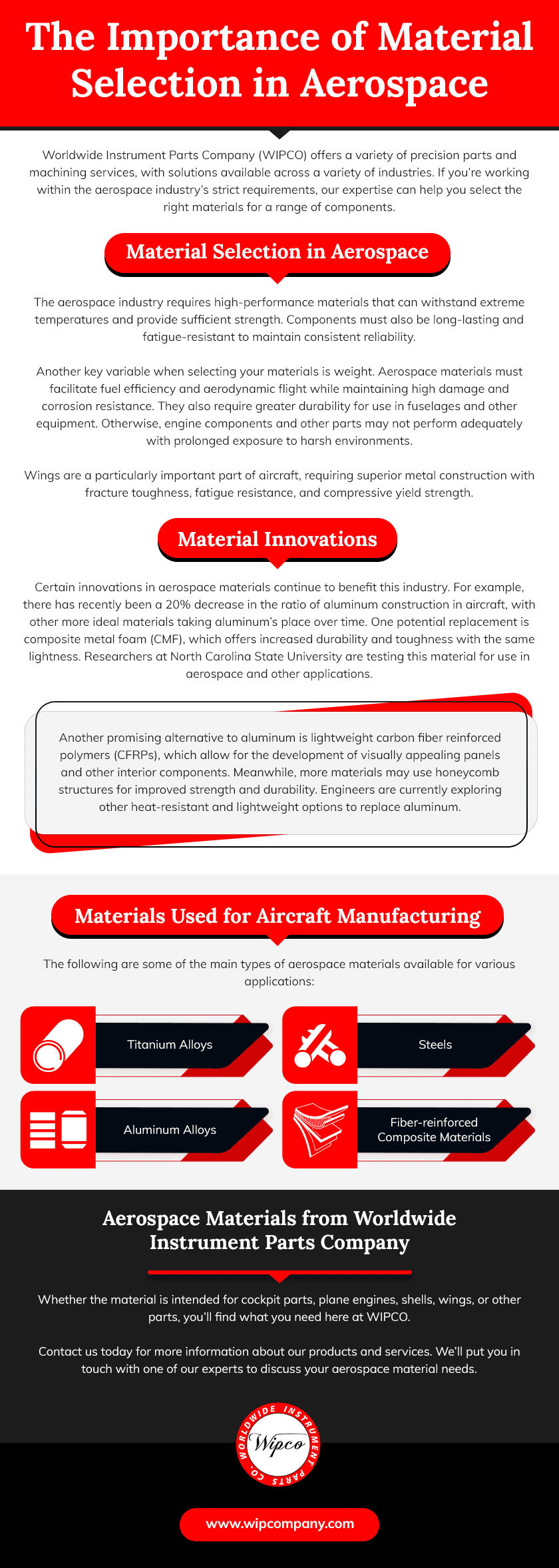Category Archive: Uncategorized
Worldwide Instrument Parts Company (WIPCO) offers a variety of precision parts and machining services, with solutions available across a variety of industries. If you’re working within the aerospace industry’s strict requirements, our expertise can help you select the right materials for a range of components. Read on to learn more.
Material Selection in Aerospace
The aerospace industry requires high-performance materials that can withstand extreme temperatures and provide sufficient strength. Components must also be long-lasting and fatigue-resistant to maintain consistent reliability.
Another key variable when selecting your materials is weight. Aerospace materials must facilitate fuel efficiency and aerodynamic flight while maintaining high damage and corrosion resistance. They also require greater durability for use in fuselages and other equipment. Otherwise, engine components and other parts may not perform adequately with prolonged exposure to harsh environments.
Wings are a particularly important part of aircraft, requiring superior metal construction with fracture toughness, fatigue resistance, and compressive yield strength.
Material Innovations
Certain innovations in aerospace materials continue to benefit this industry. For example, there has recently been a 20% decrease in the ratio of aluminum construction in aircraft, with other more ideal materials taking aluminum’s place over time. One potential replacement is composite metal foam (CMF), which offers increased durability and toughness with the same lightness. Researchers at North Carolina State University are testing this material for use in aerospace and other applications.
Another promising alternative to aluminum is lightweight carbon fiber reinforced polymers (CFRPs), which allow for the development of visually appealing panels and other interior components. Meanwhile, more materials may use honeycomb structures for improved strength and durability. Engineers are currently exploring other heat-resistant and lightweight options to replace aluminum.
Materials Used for Aircraft Manufacturing
The following are some of the main types of aerospace materials available for various applications:
- Titanium Alloys. Many aerospace components use fatigue-resistant titanium alloys, which have a high tensile strength and fatigue strength ratio. Some alloys can also resist temperatures as high as 400 to 500 C.
- Steels. While their high density limits their use in aircraft construction, some alloys work for small component castings. In this case, their high stiffness, strength, and damage resistance prove highly useful.
- Aluminum Alloys. Although aerospace applications often seek replacements for aluminum, these alloys are still popular because of their flexibility. Applications may use aluminum with other metals to enhance mechanical properties while maintaining lightness in use.
- Fiber-reinforced Composite Materials. Aircraft could also use fiber-reinforced composites that contain fibrous carbon, glass, or other materials in resinous epoxy or plastic matrices. These materials allow for increased chemical and mechanical protection.
Aerospace Materials from Worldwide Instrument Parts Company
Need high-quality, reliable aerospace materials for components? Worldwide Instrument Parts Co. can help you find the right solution through dependable precision computer numerical control (CNC) machining. We’ll work with you to identify the right material for your application, so you can enjoy optimized performance while protecting key components.
Whether the material is intended for cockpit parts, plane engines, shells, wings, or other parts, you’ll find what you need here at WIPCO.
Contact us today for more information about our products and services. We’ll put you in touch with one of our experts to discuss your aerospace material needs.
Inconel machining is an art form in and of itself. It requires a blend of expertise, precision engineering, and specialty tools to achieve the desired result. Additionally, it is widely used in industries as diverse as aerospace and automotive manufacturing thanks to its exceptional qualities.
If you’re looking for a material that offers top-notch performance when it comes to repeated motions or parts exposed to stress over time – Machined Inconel may be just what you need! Let us explain more about working with this classic alloy so that you can make the right decision for your next project.
What is Inconel?
Inconel is an alloy of nickel that contains chromium and iron. It is referred to as a superalloy due to its exceptional resistance against oxidation, corrosion, and high temperatures. Apart from these properties, Inconel is also known for its incredible tensile strength that allows it to withstand stressful settings, such as high pressures and mechanical loads.
Although Inconel isn’t the only hard material that’s tough to machine, it does present some unique challenges that require specialized tools and techniques.
Typical Uses for Inconel
Inconel is commonly used in rugged environments due to its amazing pressure, temperature, and corrosion-resistant benefits.
Some of its common uses include:
- Propeller blades
- Down-hole equipment
- Nuclear power plant reactors
- Marine equipment
- Propulsion motors
- Firearm sound suppressor baffles
Why is Machining Inconel Difficult?
Inconel’s durability delivers superior performance in strenuous environments but this presents some unique challenges. Inconel’s durability means it’s not an easy alloy to work with.
The main reasons and challenges associated with Inconel machining include the following:
- High work hardening: Inconel has a high hardening rate, making it harder and stronger the longer you work on it. Therefore, this makes it tougher for operators to achieve the desired shape or cut.
- Generates heat easily: While machining Inconel, it generates a lot of heat that can cause thermal damage and dimensional instability.
- Hard to cut: Inconel is one of the hardest materials to cut, which results in tool wear.
- Workpiece deflection: Inconel alloys easily deflect during machining, so there are plenty of dimensional inaccuracies if not adequately controlled.
Inconel Machining Tips to Remember
Understanding Inconel’s properties will help compensate for its limitations. While it presents many challenges, it’s still possible to machine Inconel successfully.
Here are some valuable tips to keep in mind when machining Inconel:
- Check tooling for signs of wear while machining Inconel: Tooling doesn’t last a long time when machining materials as tough as Inconel. Checking on the tooling during the machining process is essential to ensure quality.
- Use coolant: Since Inconel generates heat during machining, using a coolant can prevent thermal damage since the temperature is kept down.
- Opt for ceramic tools: Fast and continuous cuts are crucial to minimize work hardening. With this in mind, specialists highly recommend ceramic tools for uninterrupted cuts.
- Post-machining operations: To achieve a specific project’s needs, post-machining operations are necessary to accomplish consistent quality results.
Consider Expert Manufacturers for Superior-Quality Machined Inconel Products
With the many difficulties in machining Inconel, working with experienced manufacturers who understand the materials they work with should be a fundamental choice. WIPCO is a reputable precision machining expert who can produce accurate and precise outcomes without compromising quality.
If you want to know more about our range of services and how we have become leaders in the Inconel machining process, contact us today for more information!
From prototyping to production, machining stainless steel can be complex and confusing. With so many variables like material hardness, cutting tools, and the correct machining method, even professionals have a hard time knowing where to begin.
Fortunately, our guide for stainless steel machining will make things easier for you. We’ll look at the basics, such as various machining techniques to expert tips when working with stainless steel and its unique properties, arming you with the information you need for a successful project every time.
What is Stainless Steel?
Stainless steel is known for having high tensile strength. It also has excellent corrosion resistance, which is why it’s a preferred material across numerous demanding industries despite it being notoriously difficult to machine. However, with the proper machining procedures and tools, machining stainless steel can be achieved efficiently.
Five categories of machinable stainless steels:
- Austenitic stainless steels: Austenitic steels are denoted by numbers in the 300 range and are known as the most common form of stainless steel with high corrosion resistance and outstanding post-machining formability.
- Ferritic stainless steels: Ferritic steels have high resistance to stress corrosion cracking and oxidation in high temperatures, which are ideal in applications where the components interact with corrosive chemicals.
- Martensitic stainless steels: Martensitic steels have the same structure as ferritic steels but with a higher carbon percentage, thus, resulting in superior wear resistance and robustness.
- Duplex stainless steels: Duplex steels are twice as strong as ferritic and martensitic steels that can withstand erosion and degradation. It demonstrates stress corrosion cracking resistance, applicable for underwater applications.
- Precipitation-hardened stainless steels: Precipitation-hardened steels offer superb strength and mechanical properties while retaining their corrosion resistance, especially when they undergo heat treatments.
Various Stainless Steel Machining Processes
There are numerous machining methods you can choose from to create stainless steel parts. Below are some of the most common methods used in different industries:
- Milling: Milling stainless steel involves high-speed rotating cutting tools that remove material on a stationary workpiece. It’s known for accomplishing highly accurate stainless steel parts and components with an incredibly smooth cutting edge.
- Turning: Turning is one of the most commonly used machining methods for stainless steels that utilizes a stationary cutting tool and a rotating workpiece. It’s imperative to keep the tool’s overhang minimal when machining stainless steel.
- Laser Cutting: An amplified light beam is used to melt and cut through stainless steel, which makes laser cutting an effective method for thin metal sheets.
- Drilling: Commonly used as a secondary machining process with other metalworking techniques is drilling. It’s primarily utilized for creating holes with small diameters.
Tips for Machining Stainless Steel
For ease and efficiency, here are some tips for machining stainless steel:
- Opt for high-quality materials: Choosing the best stainless steel grade can help you accomplish the smoothest operations.
- Add coolant: Prevent work hardening by adding coolant to the cutting tool to reduce difficulty in machining stainless steel.
- Proper tool material: The right tooling material can produce superior results. Furthermore, ensuring that the machine setup is tight will prevent tool chatter, a common culprit of poor machining.
- Lubrication: Lubricants are essential during machining as they prevent friction between the tooling and material. Additionally, lubricants can wash away material residue from the workpiece and tools.
Accomplish High-Performance Stainless Steel Parts with the Right Manufacturer
Machining stainless steel requires expertise and experience, so it’s crucial to partner with a trusted manufacturer with extensive knowledge of this challenging material. At WIPCO, we have state-of-the-art equipment, advanced technologies, and a team of skilled professionals dedicated to delivering high-quality stainless steel parts for your specific requirements.
Contact us now to learn how we can deliver top-quality outcomes for your projects. You can also request a quote, and we can find a cost-effective solution tailored to your needs!

